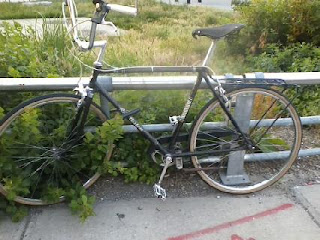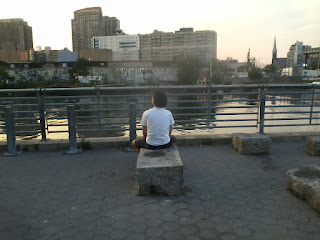Yesterday I was riding up and down Hipster Hook. As far as I know , it’s not an official designation. Roughly,it extends along the waterfront from the Brooklyn Navy Yard to the Socrates Sculpture Park, about a kilometer from my apartment.
Along its length, an interesting combination of bikes are parked on its streets. Some were inherited from parents or other family members. Others were bought in yard sales, retrieved from basements or have more mysterious or unspeakable provenances, if you know what I mean. Then there are the Dutch city bike- shaped objects and objects shaped like imitations or mockeries of vintage bikes.
In the latter category, I saw this on Franklin Avenue in Greenpoint, near the dead center of the Hook:
It looks like a Motobecane mixte from the ‘70’s, sort of. Emphasis on the “sort of”:
Fortunately, a really nice vintage bike was parked just a few sign posts away:
Miyata has long been one of the mass manufacturers I respect most. This particular bike is interesting because it alsobears the Koga name on its head tube. To my knowledge, only in Europe were Miyatas sold as “Koga-Miyata.”
Along its length, an interesting combination of bikes are parked on its streets. Some were inherited from parents or other family members. Others were bought in yard sales, retrieved from basements or have more mysterious or unspeakable provenances, if you know what I mean. Then there are the Dutch city bike- shaped objects and objects shaped like imitations or mockeries of vintage bikes.
In the latter category, I saw this on Franklin Avenue in Greenpoint, near the dead center of the Hook:
Fortunately, a really nice vintage bike was parked just a few sign posts away:
Miyata has long been one of the mass manufacturers I respect most. This particular bike is interesting because it alsobears the Koga name on its head tube. To my knowledge, only in Europe were Miyatas sold as “Koga-Miyata.”




































